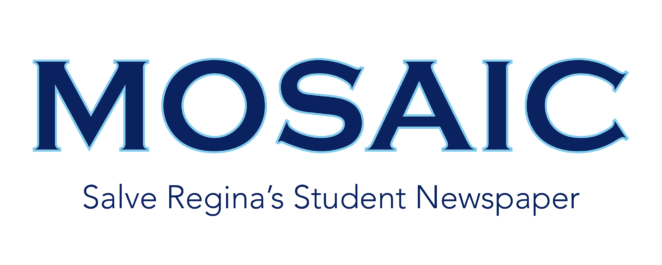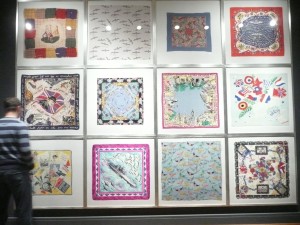By Mia Lupo –
When we think of American propaganda during World War II, we think of the graphic posters illustrating marching soldiers and Uncle Sam urging the reader to “BUY WAR BONDS.” We picture Rosie the Riveter wearing her red bandana and blue shirt, flexing her arm, telling female viewers “WE CAN DO IT” and contribute to war effort. We remember the government encouraging families to plant fruits and vegetables at home—“YOUR VICTORY GARDEN COUNTS MORE THAN EVER!”
When we think of war propaganda, we certainly do not think of beautifully crafted silk scarves.The “Beauty as Duty” exhibit at the Museum of Fine Arts in Boston showcases the role of textiles in Britain during World War II. Although clothing had to conform to government regulation, the clothing still remained fashionable.
The exhibit shows examples of typical “utility” dress during the war effort, such as women’s day-dresses, but it is centralized around scarves. Textile firms created silk and rayon blend scarves with beautiful, yet inspiring, printed images that related to the war effort abroad and at home.
Most of the scarves in the exhibit were produced by an upscale textile and fashion firm named Jacqmar. The firm was founded by Joseph “Jack” Lyons and his wife Mary in the 1930s. Jacqmar earned its reputation for its propaganda printed scarves designed by the firm’s in-house visionary, Arnold Lever.
Unlike the United States, Britain was much closer to the battles in Europe. The German army heavily attacked London for eight months, from September 1940 until May 1941, a period known as “The Blitz”. Despite the damage inflicted on London, it ultimately marked a turning point in the war—the bombings were a futile effort by Hitler and his forces to disable Britain’s Royal Air Force. Even after the Allies won World War II, the British still suffered from food and clothing shortages.
Scarves, like those by Jacqmar or Ascher, were not deemed utility clothing, so they were still subject to taxation. Nevertheless, printed scarves were in popular demand for the duration of the 1940s.
Jacqmar scarves cost 55 shillings and 10 pence, the modern equivalent of about $125 USD. Lower priced scarves were also available for about five shillings or $10 USD. My favorite scarf in the exhibit featured Winston Churchill the Prime Minister of England and prominent leader during World War II. The rayon scarf was printed around 1943, and manufactured by Filmyra Fabrics in a wide variety of color schemes.
A Churchill quote is printed around the scarf’s borders: “We will fight on the seas and oceans. We shall fight with glowing strength and confidence in the air. We shall defend our island whatever the cost may be.” These words capture the British spirit of fortitude and hope that supported the people during the war effort.
Britain still communicates their national pride in their fashions today. Interestingly enough, Jack Wills, a British chain-boutique, has a Jacqmar inspired scarf for the summer season. The Heatherwood scarf features a similar design, brags the vivid color palette, and displays the same British glory by displaying the country’s flags.
“Beauty as Duty”: Textiles and the Home Front in WWII Britain will be on display until May 28, 2012 in the Hilles Gallery 152 Selection.















